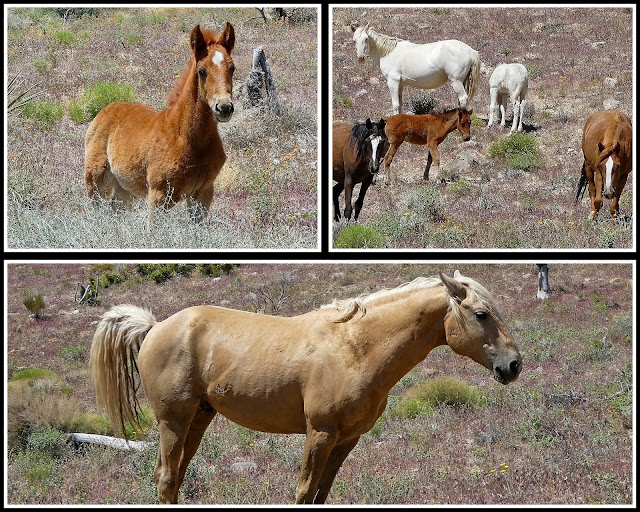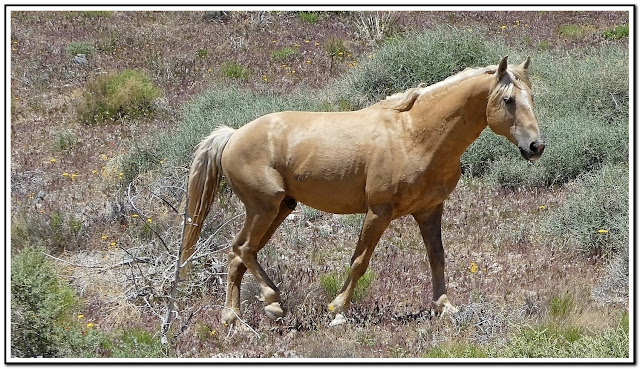This page last updated on 04/05/2017
 |
| (Fig. 01) |
 |
| (Fig. 01A - Museum Building) |
Description: Inside the Anna Robert Parks Exhibit Hall (Fig. 01) is a gift shop
and bathrooms. The inside exhibits of the museum takes museum visitors through a historical journey from the Ice Age to Age of Entertainment (Fig. 01A). The timeline chronicles the history and culture of the ancient Pueblo and more recent Paiute, the first Anglo pioneers and their daily lives, early town-sites and land auction camps, mining technology and the gaming and entertainment heritage of Las Vegas. The Heritage Gallery changing exhibits feature art and artifacts in their historical context. There's lots of great old Vegas memorabilia. Each of these exhibits are very well done and provide lots of historical information. The outside area of the museum property is about 30 acres in size (Fig. 02). There is an Old ghost town type buildings, wagons and a Mojave Desert nature walking trail. A huge old Union Pacific locomotive, also a caboose, and lots of other train stuff. The best part of the museum is the old replica city block; filled with restored homes from the 1930's to the 50's. There's even a old replica motor court complete with camper. Heritage Street homes offer doorways into past decades, from the 1910s to the 1970s. The Boulder City depot and collection of railroad cars recall the railroad heritage of southern Nevada, while the arrested decay along the Ghost Town and Mining Trail offers a perspective on life in the hot and arid Southwest environment. Visitors and spent about two hours here taking tours of each of the buildings and homes.
 |
| (Fig. 02 - Heritage Street Homes) |
04/05/2017 Trip Notes: On this date I took Jim Herring and Blake Smith to the Clark County Museum. After touring and viewing all the exhibits in the museum proper (Fig. 1A), we went outdoors to tour the grounds. Walking to the Northwest corner of the 30-acre site we toured the collection of restored historic buildings on Heritage Street (Fig. 02) that depict daily life from different decades in Las Vegas, Boulder City, Henderson and Goldfield. Starting with the Townsite House (Fig. 03), we toured the interiors of each of the eight restored buildings. For information on some of the homes are shown below (Figs. 03 thru 08). The print shop is a replica that was built in a style that was popular during the late 1800's and early 1900's. It is filled with a variety of printing equipment used by print shops and newspapers during 1890's to the 1940's. Next was the "Mobile America". The most interesting was the Spartenette Trailer (Fig. 04), built in 1948. It was moved from the Golden Rule Trailer Court, Pittman (Henderson) and restored to the time period of the 1960's. Considering its age, we were amazed by how "roomy" it was. The Babcock & Wilcox House (Fig. 05) was one of 12 houses constructed in April of 1933 for Babcox and Willcox Company employees during the construction of the Hoover Dam. The Giles/ Barcus House was built in 1924 in Goldfield, Nevada and was later moved to 57 E. Hacienda, Las Vegas, Nevada in 1955. It was moved to the museum in 1991 and restored to the period of an Odd Shop Antique Store. Probably the most expensive and elaborate home was the Goumand House. The last host was the Beckly House (Fig. 08). (con't below)
 |
| (Fig. 03) |
The Townsite House: The Townsite House was moved here from 302 West Basic, Henderson. A three bedroom house, it is in the style of Government Temporary housing built during the building of the B.M.I's magnesium processing Plant. The town-site included 1,000 houses that, in 1944, officially became Henderson, named in honor of Charles B Henderson, a Nevada attorney and U.S. Senator. The interior walls are made of 1/4" plywood with batten strips covering the seams. The windows are situated to provide cross ventilation and a six-sided swamp cooler provided comfort during the hot weather. It was moved here in 1982 and the restored time period is 1940's.
 |
| (Fig. 04) |
Mobile America: We found the "Mobile America" area quite interesting. There was a Motor Court Cabin build in the 1930's. It was moved in 1987 and opened in 1997 after restoration in 1997. In the 1930's, automobile travel by average families made it necessary to create affordable accommodations. Motels were one-story, often separate buildings, with parking next to or in front of the room.
 |
| (Fig. 05) |
Babcock & Wilcox House: The Babcock & Wilcox House was one of 12 houses constructed in April of 1933 for Babcox and Willcox Company employees during the construction of the Hoover Dam. It was moved from 441 Hotel Plaza in Bolder City in 1987 and was restored to the time period of the 1930's. This two bedroom home had a half-basement accessible from the laundry porch. The screened porch often served as a sleeping porch during he hot nights of summer.
Giles/Barcus House: The Giles/Barcus House was built in 1924 in Goldfield, Nevada and was later moved to 57 E. Hacienda, Las Vegas, Nevada in 1955. It was moved to the museum in 1991 and restored to the period of an Odd Shop Antique Store.
 |
| (Fig. 06) |
Goumond House: The Goumond House, a Tudor Revival style, was built in 1931. It was moved in 1984 and restored to a period of 1950. It was purchased by Pros J. Goumond, owner of the Boulder Club on Fremont Street. A full basement sat under the home in its original location and it also featured one of the first private swimming pools in Las Vegas. Moving required the removal and separate transportation of the rock-work and carport, that now houses a 1959 Studebaker Lark (Fig. 07). Once at the museum, all parts were reinstalled and renovation took over ten years.
 |
| (Fig. 07) |
 |
| (Fig. 08) |
Beckley House: The Beckley House is a bungalow California style house that was built in 1912 at 120 S. Fourth Street. Over the years, as the family grew, they added on four rooms. Leva Beckley lived in the house until 1978, when at age 93 her ill health forced her to move in with family members. A local landmark because it was the last pioneer home left in downtown Las Vegas, it was finally donated to the museum in 1979. It was restored to a period of 1920's.
 |
| (Fig. 09) |
 |
| (Fig.10) |
Trip Notes Continued: We then wandered over to the the 1932 Boulder City Depot and a real 1918 Union Pacific steam engine and collection of railroad cars that recall the railroad heritage of southern Nevada (Fig. 09). We even walked through the old-time Crummy, (railroad talk for caboose) (Fig. 10). We then entered the mining exhibit filled with mineral specimens; wandered though a resurrected ghost town and a half-mile nature trail; and a pueblo of the ancient ones. Though most of the items in these areas are in much decay, many items offer a perspective on life in the hot and arid Southwest environment (Fig. 11). No matter what your age, the Clark County Museum is a place where you can explore the rich and colorful history of Southern Nevada. The Esslinger Barn (Fig. 12) was relocated in 2002 from the corner of Charleston and Lindell. It has been restored to a time period of between 1910 to 1970. It now houses personnel items from the Esslinger family and artifacts that depict the many uses od barns from cows and horses to farm equipment and wagons. There is even a car that was built by Sears and Roebuck. There is the General Store from the Last Frontier Village, c. 1950 (Fig. 13) and the Tuscarora Jail from Tuscarora, Nevada, c. 1880 (Fig. 14). In summary, we spent nearly an entire afternoon visiting this expansive museum and were both amazed by how much was available to see. This is a must see for anyone who is interested in the history of Las Vegas and southern Nevada.
 |
| (Fig. 11) |
 |
| (Fig. 12) |
 |
| (Fig. 13) |
 |
| (Fig. 14) |



















































